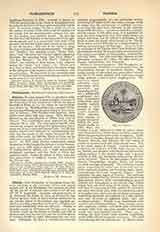

Florians (FLORIACENSES), the, an altogether independent order, and not, as some consider, a branch of the Cistercians; it was founded in 1189 by the Abbot Joachim of Flora (q.v.), by whom its constitutions were drawn up. Besides preserving a number of Cistercian observances, the founder added to the austerities of Citeaux. The Florians went barefoot; their habits were white and very coarse. Their Breviary differed in the distribution of Offices from that of Citeaux. The constitutions were approved by Pope Celestine III in 1196. The order spread rapidly, soon numbering as many as thirty-five monasteries, but it seems not to have extended beyond Italy. In 1470 the regular abbots were replaced by commendatory abbots, but the abuses of this regime hastened the decline of the order. In 1505 the Abbey of Flora and its affiliated monasteries were united to the Order of Citeaux. In 1515 other Florian monasteries united themselves to the Grande Chartreuse or to the Dominicans, and in 1570, after a century under the regime of commendatory abbots, not a single independent monastery remained, and the Order of Flora had ceased to exist. Under the Abbot of Flora were also four monasteries of religious women, who followed the Florian rule.
EDMOND M. OBRECHT

